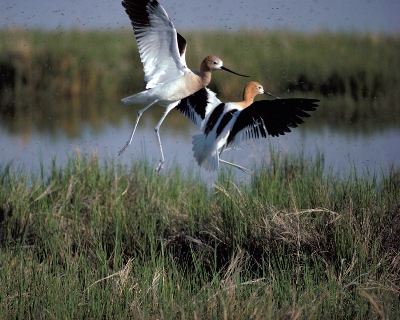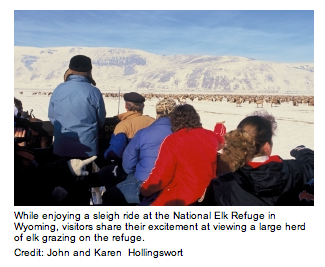Fire up the grill. Pull out the road maps. It’s just days to Memorial Day Weekend, the traditional start of Get-Outdoors-Summer’s-Here! Season.
 Wading birds called avocets take flight at Bear River Migratory Bird Refuge, a short ride off Interstate 15 near Salt Lake City, Utah. (USFWS)This summer, include a visit to a national wildlife refuge in your plans. Thrill to a hidden world of natural wonders while your kids learn the joy of healthy outdoor activity. Take pride in America’s Great Outdoors and your natural heritage.
Wading birds called avocets take flight at Bear River Migratory Bird Refuge, a short ride off Interstate 15 near Salt Lake City, Utah. (USFWS)This summer, include a visit to a national wildlife refuge in your plans. Thrill to a hidden world of natural wonders while your kids learn the joy of healthy outdoor activity. Take pride in America’s Great Outdoors and your natural heritage.
Here’s another good reason to visit a national wildlife refuge:
National wildlife refuges make great mid-route stops on long drives. The shortest of detours off many interstate highways lead to federally protected wildlife havens and relief for your jangled nerves.
Just two examples:
• Heading south to Florida on I-95? In South Carolina, take exit 102 to Santee National Wildlife Refuge, a few minutes away. Scenic Santee Refuge is a magnet for hawks, eagles, wading birds and songbirds. It’s the historic stomping grounds of Revolutionary War hero Francis “Swamp Fox” Marion. And it’s an anthropological wonder — the site of 1,000-year-old National Register-listed ceremonial Santee Indian mounds.
Many animals may be hibernating, but winter is a perfect time for people to get outside and enjoy America’s national wildlife refuges. Go for a hike. Sight a bird. Restore your sense of wonder. The National Wildlife Refuge System, managed by the U.S. Fish and Wildlife Service, is the world’s premier system of public lands and waters set aside to conserve America’s fish, wildlife and plants. There is a National Wildlife Refuge within an hour’s drive of most major cities.
 Here is a sampling of upcoming refuge events:
Here is a sampling of upcoming refuge events:
Strap on Your Skis
Now thru mid-March — Horicon National Wildlife Refuge, WI
Hike, snowshoe, x-country ski Horicon Refuge for wildlife watching & photography. Learn more about Horicon Refuge.
Take a Sleigh Ride
Now thru March, 10 a.m. to 4 p.m. daily — National Elk Refuge, WY
Take a horse-drawn sleigh ride past an elk herd numbering in the thousands. Reservations needed. Buy tickets (adults $18; ages 5-12 $14; under 5 free) at the Jackson Hole and Greater Yellowstone Visitor Center, 532 North Cache Street, several blocks north of Jackson’s Town Square. Visitor Center hours are 9 a.m. to 5 p.m. daily. Sleigh rides last about one hour, including the shuttle ride to and from the sleigh ride site. Accommodations for visitors with disabilities. Learn more about National Elk Refuge.
Join an Eagle Watch
Friday, January 7, and Saturday, January 8, 4 p.m. to 6 p.m. — Salt Plains National Wildlife Refuge, OK
Learn about eagles, then take a hayride to an eagle hotspot to see eagles fly in to roost for the evening. Reservations are required. Wear warm, neutral-colored clothing. Bring a thermos or hot mug. Hot chocolate provided.
Island Vacations – Easy on the Pocketbook
See a National Wildlife Refuge
When vacationers think of islands, many envision far-off and expensive destinations. Yet, the National Wildlife Refuge System – a network of public lands that spans about 97 million acres – offers a range of island destinations. From Alaska’s remotest islands in the Arctic Ocean to the subtropical “Spanish Virgin Islands” of Puerto Rico – as well as others scattered across the country — the Refuge System’s islands provide essential habitat for a vast array of birds and other wildlife. They offer enhancement to visitors who venture off the beaten path to experience them. The National Wildlife Refuge System is composed of 548 national wildlife refuges, with at least one in every state.
Ohio River Islands Refuge, Pennsylvania
It’s only 35 miles from Pittsburgh, but a world apart. Phillis Island, in Ohio River Islands National Wildlife Refuge, is a popular stopping place for recreational boaters to picnic on the sandy beach, fish for bass or simply watch the river go by. In fall, hunters pursue waterfowl or archery hunt for deer that swim to the island.
Ohio River Islands National Wildlife Refuge stretches 362 miles of the upper Ohio River, from Pennsylvania to Kentucky, with 22 scattered islands and three mainland properties. While most of the islands are accessible only by boat, Middle Island, near St. Marys, WV, has a bridge with road access. This is the most commonly visited island in the refuge, and the largest at 235 acres.
The refuge, created in 1990, aims to “protect the Wild Ohio” by conserving habitat for migratory birds, freshwater mussels and other wildlife along the river. “The Ohio River has been regarded as a resource for industry, not so much a resource for wildlife. Now we see it has multiple dimensions,” says Visitor Services Manager Janet Butler. The Clean Water Act of 1972 improved the Ohio River’s water quality, reviving wildlife populations on and along the river, and making it more appealing for recreation, she says.
The islands of Ohio River Islands Refuge are among thousands within the National Wildlife Refuge System. For more information about the Ohio River Islands Refuge see http://www.fws.gov/refuges/profiles/index.cfm?id=51660
Here is a sampling of some of the Refuge System’s other island jewels:
Oregon’s Spectacular Coast
From nearly every viewpoint on the Oregon coast, colossal rocks jut out of the Pacific Ocean creating postcard images. These rocks are protected as part of Oregon Islands National Wildlife Refuge. The refuge includes 1,854 rocks, reefs and islands and two headland areas spanning 320 miles of the Oregon coast.
From April to August, the rocks and islands are covered with birds. The majority of Oregon’s estimated 1.2 million seabirds, including 13 different species, breed on the refuge. “They pack on any available space during breeding season,” says Visitor Services Manager Dawn Grafe. Seals and sea lions also use the rocks as “haulout” sites for resting and pupping. Simpson Reef near Charleston frequently hosts 6,000 seals and sea lions.
The birds and marine mammals found on the offshore rocks, reefs and islands are extremely susceptible to human disturbance, so the rocks are closed to the public year-round. But visitors get phenomenal views of the refuge and its wildlife from many state parks and other open spaces along the mainland. Mainland sites with viewing decks overlooking seabird colonies include Ecola State Park, Cape Meares State Scenic Viewpoint, Yaquina Head Outstanding Natural Area, Heceta Head State Scenic Viewpoint, and Harris Beach State Park. Coquille Point, a unit of Oregon Islands National Wildlife Refuge, is also open to visitors.
One unit of the Oregon Island Refuge that is open to visitors is Cape Meares National Wildlife Refuge, where people can see one of the few remaining stands of coastal old growth forest in Oregon and the state’s largest Sitka spruce, estimated to be 700 to 800 years old. Visit Cape Meares Refuge between April and June each year, and see the fastest animal in the world – the peregrine falcon – raising chicks along the rocky headland. A pair of peregrine falcons has nested on the refuge since 1987. Hikers can enjoy several trails that wind through the headland and old-growth forest.
Also open to visitors is Haystack Rock at Cannon Beach, the best known island of Oregon Islands Refuge, which juts 235-foot out into the ocean. At low tide, visitors can nearly walk up to it and explore nearby tidepools while tufted puffins fly overhead. Spotting scopes are available so visitors can get close-up views of the puffins.
For more about Oregon Islands National Wildlife Refuge, see: http://www.fws.gov/oregoncoast/oregonislands/index.htm.

